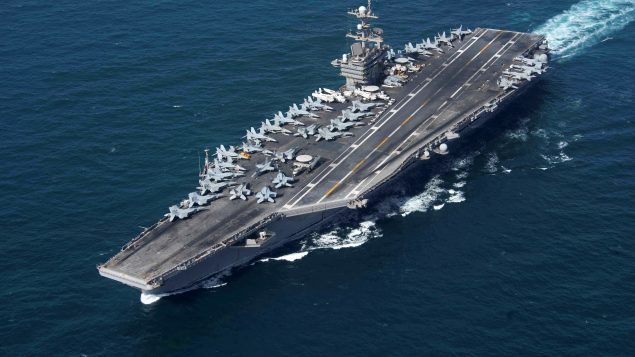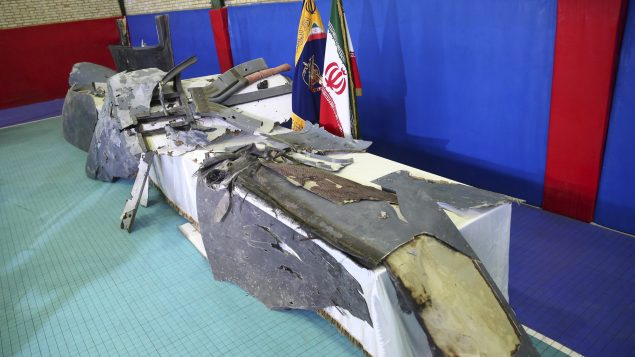While several international airlines are scrambling to reroute flights over the Persian Gulf amid growing tensions between the U.S. and Iran, Canadian airlines say the crisis has had no bearing on their operations.
Several airlines rerouted flights Friday to avoid airspace near the Strait of Hormuz after Iran shot down a U.S. military surveillance drone there and American aviation officials warned that commercial jetliners could be mistakenly attacked amid tensions between Tehran and Washington.
“The threat of a civil aircraft shootdown in southern Iran is real,” warned OPSGROUP, a company that advises airlines, citing as an example the downing of a Malaysia Airlines jetliner over eastern Ukraine in 2014, killing all 298 aboard.
The Federal Aviation Administration warned of a “potential for miscalculation or misidentification” in the region after an Iranian surface-to-air missile on Thursday brought down a U.S. Navy RQ-4A Global Hawk, an unmanned aircraft with a wingspan larger than a Boeing 737 jetliner and costing over $100 million. The U.S. said it made plans for limited strikes on Iran in response, but then called them off.

A U.S. Northrop Grumman RQ-4 Global Hawk unmanned aerial vehicle similar to the one shown, has been shot down over the Strait of Hormuz, Iran says was in its airspace, the U.S. says it was in international airspace (Erik Hildebrandt/U.S. Navy/Northrop Grumman/Handout via REUTERS)
The FAA said its warning would affect the area of the Tehran Flight Information Region. An FAA map showed that area extending from Iran’s southern border roughly a dozen miles out to sea along the Persian Gulf, the Gulf of Oman and the Strait of Hormuz, the narrow connection between the two bodies of water through which 20 per cent of the world’s crude oil passes.
“FAA remains concerned about the escalation of tension and military activity within close proximity to high volume civil air routes and the Iran’s willingness to use long-range (surface-to-air missiles) in international airspace with little to no warning,” the agency said. “As a result, there is concern about the potential for misidentification or miscalculation which could result in the inadvertent targeting of civil aviation.”
Monitoring the situation
Annie Joannette, a spokesperson for Transport Canada, said they are aware of the current situation regarding the FAA’s advisory for air operators flying over the waters of the Persian Gulf.
“Transport Canada will continue to monitor the situation, but at this time has not issued any advisory warnings,” Joannette said.
Air Canada spokesperson Isabelle Arthur said because of their current routings “there has been no or minimal impact on our flying in the region.”
Air Transat and WestJet said they have no flights to the region.
Capt. Leah Campbell, a spokesperson for the Canadian Armed Forces, said the Canadian military, which maintains a presence in Bahrain, Kuwait and Iraq, has not modified its flight plans in the region to avoid any particular area.
“Our personnel continually monitor the security environment and provide threat assessments,” Campbell said. “It is essential that the CAF thoroughly assess such threats and implement appropriate measures to ensure the safety and security of deployed personnel.”
‘Cocked & loaded’

The U.S. Navy aircraft carrier USS John C. Stennis transits the Strait of Hormuz, while deployed in the U.S. 5th Fleet area of operations Jan. 20, 2019. (Mass Communication Specialist 2nd Class Joseph Mille/U.S. Navy/r/Handout via REUTERS)
A U.S. official told the Associated Press the military had prepared limited strikes on Iran in retaliation for downing the drone, but approval was abruptly withdrawn Thursday night before the attacks were launched. The official, who was not authorized to discuss the operation publicly and spoke on condition of anonymity, said the targets would have included radars and missile batteries.
President Donald Trump said the U.S. was “cocked & loaded” to attack three sites in Iran before he halted the assault over concerns about casualties.
With files from The Associated Press







For reasons beyond our control, and for an undetermined period of time, our comment section is now closed. However, our social networks remain open to your contributions.